
Smooth sailing or choppy waters for Australia, NZ and the US in the Pacific?
by Anna Powles , Joanne Wallis
Last week’s announcement that US President Joe Biden would not travel to Papua New Guinea to meet with Pacific Islands Forum leaders was met with disappointment. Expectations were high: the White House had labelled the visit ‘historic’—it would have been the first time a sitting US president visited a Pacific island country—and claimed it would further reinforce the ‘critical partnership’ between the US and the Pacific islands. The meeting was a follow-up to the first-ever US–Pacific Island Country Summit held in Washington last September. But as far as sequels go, this one was a fizzer. Biden’s planned visit was looking shaky even before news of its cancellation, with controversary following leaks about the proposed US–PNG defence cooperation agreement. But the PIF leaders went ahead with their meeting, and the decision by New Zealand Prime Minister Chris Hipkins to attend, despite neither Biden nor Australian Prime Minister Anthony Albanese going, sent a strong signal to the Pacific of New Zealand’s commitment to the region. The Australian government has missed an opportunity to send a clear message that Australia shows up in the Pacific even when its larger alliance partner, the US, doesn’t. This brings us to the challenges facing Australia and New Zealand. In response to geopolitical shifts in the region and more broadly, Australia, New Zealand and the US have individually, and in cooperation with each other, sought to enhance their relationships with Pacific island countries and deepen their involvement in the region. However, as we argue in our new ASPI report, released today, cooperation between the three partners faces several challenges—and raises questions for Australia and New Zealand. Despite the rhetoric—at times tokenistic—from the three partners about respecting Pacific agency, ambitions and activism, genuine change requires the kind of mindset shift that may prove challenging, particularly for the US. For example, the Partners in the Blue Pacific initiative reflects outdated modes of thinking about the power dynamics underpinning the three nations’ activities in the Pacific. There are limits to the assumed leadership of Australia, New Zealand and the US, as the Solomon Islands – China security agreement highlighted. China, and others, are here to stay. Pacific island countries have options—and alternatives—to their status quo relationships. As unwelcome as Australia, New Zealand and the US may find China’s presence in the region, they need to plan for how they will work alongside a range of partners in the Pacific. This isn’t about accommodation, necessarily, but nor is it about constraint when Pacific island countries pursue their own interests. It’s becoming harder for the three partners to balance their interests and values while at the same time attempting to reconcile broader strategic interests with Pacific priorities. Australia, New Zealand and the US pride themselves on being liberal democratic nations committed to upholding human rights and the international rules-based order. But respect for those values is being tested by their perceived need to advance their strategic interests. Controversy over the AUKUS partnership raises questions about how closely the partners want to relate to each other in the Pacific islands region. Differences among Australia, New Zealand and the US mean that, in some instances, they may wish to carefully consider risks to their reputations and to their individual relationships with Pacific island countries. This includes New Zealand’s stance on nuclear issues, as well as Australia’s and New Zealand’s abilities, as members of the Pacific Islands Forum, to act as a constraining influence on US ambitions in the Pacific when they cut across collective Pacific interests. The US needs to appreciate that Australia and New Zealand are bound to the Pacific through geography, history, constitutional relationships and, increasingly, identity. The challenges we outline in our report are not insurmountable. But how Australia, New Zealand and the US partner with the Pacific—and with each other—matters deeply. These considerations take conventional responses to strategic competition in the region beyond the binary reaction to China as the destabilising actor, and demand that the three partners reflect on their own contributions to peace and security. We therefore recommend that, when seeking to enhance their engagement in the region and work together, Australia, New Zealand, and the US should ensure that Pacific priorities direct activity, not their own. It’s important for the partners to ensure that their initiatives don’t undermine or supplant existing regional frameworks but instead expand on established mechanisms. And, importantly, Australia, New Zealand and the US must avoid competing with one another and instead cooperate more closely, where appropriate, to pool their collective strengths. Biden’s reason for skipping both the Pacific Islands Forum leaders’ meeting in PNG and the Quad summit in Sydney are well understood: the US domestic debt crisis took priority. But it has reminded the Pacific island countries—and Australia and New Zealand—that, despite its protestations, the US has yet to prove that it is a reliable and consistent partner to the Pacific. It should also serve as a reminder to Australia, New Zealand and the US that the time and opportunities they have to build trust and demonstrate their reliability to their Pacific partners are not limitless.











